A Composite Exponential Reaching Law Based SMC with Rotating Sliding Surface Selection Mechanism for Two Level Three Phase VSI in Vehicle to Load Applications
Abstract
:1. Introduction
- i.
- Most of the scholarly work has focused mainly on one of the two key challenges associated with designing SMC based three phase VSI (i.e., effective reaching law and appropriate sliding surface).
- ii.
- Value of the reaching law gain performs a key role in achieving robustness, where a large value of reaching law gain serves to achieve a higher reaching speed with undesirable chattering along the sliding surface. Similarly, chattering along the surface reduces at a lower value of the reaching law gain but at the cost of the slow reaching speed of system states to the surface. Therefore, this trade-off is critical to handle and extensive high rate scholarly work has so far been conducted, however, it is the call of the day to handle this trade-off in a much better way for sensitive loads.
- iii.
- Robustness of the three phase VSI is guaranteed when the system states reach the sliding surface, however, the dynamic performance and behavior of the inverter is strictly associated with proper selection of the value of the sliding coefficient. At a smaller value of the sliding coefficient, output voltage of the inverter will take more time to track its reference due to a slower convergence rate along the sliding surface. While at a larger value of the sliding coefficient, the tracking time is reduced with an increase in the reaching time.
- iv.
- Following the severity of the above-mentioned issues, several effective techniques have so far been proposed. Keeping in mind the sensitivity associated with three phase TLVSI for V2L applications, there is still much room of improvement to achieve a high level of robustness with mitigated chattering.
- i.
- A novel reaching law function to set the value of control gain considering the distance of the system states from the sliding surface for three phase TLVSI was proposed. A higher value of control gain was set at a greater distance to ensure a high robustness and convergence rate, while the value of the control gain was lowered following the decreasing distance, and it vanished on the surface to mitigate chattering.
- ii.
- A three phase VSI with SMC based control for V2L applications was designed, comprising a rotating sliding surface selection mechanism based on single input fuzzy logic control (SIFLC) and the proposed novel composite reaching law.
- iii.
- Behavior of the proposed reaching law based SMC along with PRERL [27], RRL [29], and EERL [24] were tested on different values of gain, for the three phase VSI in the stationary frame. It was shown from the comparative analysis that the proposed reaching law performed remarkably well in achieving a low reaching time at a low value of gain and chattering as well as an extremely low reaching time without compromising much on chattering at a high value of gain.
- iv.
- The proposed reaching law based SMC, PRERL [27], RRL [29], and EERL [24] were tested on a three phase TLVSI under extreme conditions of nonlinear load. Results showed that the proposed reaching law has an extremely fast transient response with excellent voltage regulation from no load to full-load conditions. Moreover, with a fast convergence rate and high degree of robustness, the proposed reaching law offered low %THD and reduced chattering.
2. System Description
System Modeling for Three Phase VSI
3. Sliding Mode Control Design
Appropriate Sliding Surface Selection
Proposed Composite Exponential Reaching Law for Three Phase VSI
- (i)
- If the system states are far away from the sliding surface, a very high value of gain will be set to ensure the fast convergence of system states to the stable surface .
- (ii)
- If the system states are close to the sliding surface, which leads to and ; thus the value of overall gain set will be negligible and will mitigate chattering along the sliding surface.
- (iii)
- The values of are set in a way that the value of the reaching law gain becomes directly proportional to the distance of the system states from the reference sliding surface . Assume that if , then , which eventually results in a higher value of . Whereas , the value of the reaching law gain is adjusted based on the distance of system states from .
4. SMC with Proposed Reaching Law
Simulation Study
5. Experimental Results
6. Conclusions
Author Contributions
Funding
Institutional Review Board Statement
Informed Consent Statement
Data Availability Statement
Acknowledgments
Conflicts of Interest
References
- Barja-Martinez, S.; Rucker, F.; Aragues-Penalba, M.; Villafafila-Robles, R.; Munne-Collado, I.; Lloret-Gallego, P. A Novel Hybrid Home Energy Management System Considering Electricity Cost and Greenhouse Gas Emissions Minimization. IEEE Trans. Ind. Appl. 2021, 57, 2782–2790. [Google Scholar] [CrossRef]
- Kanellos, F.D.; Grigoroudis, E.; Hope, C.; Kouikoglou, V.S.; Phillis, Y.A. Optimal GHG Emission Abatement and Aggregate Economic Damages of Global Warming. IEEE Syst. J. 2017, 11, 2784–2793. [Google Scholar] [CrossRef]
- Houghton, J. Global Warming the Complete Briefing; Cambridge University Press: Cambridge, UK, 1994. [Google Scholar]
- Yuan, J.; Dorn-Gomba, L.; Callegaro, A.D.; Reimers, J.; Emadi, A. A Review of Bidirectional On-Board Chargers for Electric Vehicles. IEEE Access 2021, 9, 51501–51518. [Google Scholar] [CrossRef]
- Shirazul, I.; Iqbal, A.; Marzband, M.; Khan, I.; Al-Wahedi, A.M.A.B. State-of-the-art vehi-cle-to-everything mode of operation of electric vehicles and its future perspectives. Renew. Sustain. Energy Rev. 2022, 166, 112574. [Google Scholar]
- Curkovic, M.; Jezernik, K.; Horvat, R. FPGA-Based Predictive Sliding Mode Controller of a Three-Phase Inverter. IEEE Trans. Ind. Electron. 2013, 60, 637–644. [Google Scholar] [CrossRef]
- Sayed, K.; Almutairi, A.; Albagami, N.; Alrumayh, O.; Abo-Khalil, A.G.; Saleeb, H. A Review of DC-AC Converters for Electric Vehicle Applications. Energies 2022, 15, 1241. [Google Scholar] [CrossRef]
- Hasan, M.; Mekhilef, S.; Ahmed, M. Three-phase hybrid multilevel inverter with less power electronic components using space vector modulation. IET Power Electron. 2014, 7, 1256–1265. [Google Scholar] [CrossRef]
- Dezhi, X.; Liu, J.; Yan, X.; Yan, W. A novel adaptive neural network constrained control for a mul-ti-area interconnected power system with hybrid energy storage. IEEE Trans. Ind. Electron. 2017, 65, 6625–6634. [Google Scholar]
- Chiang, S.; Tai, T.; Lee, T. Variable structure control of UPS inverters. IEE Proc.-Electr. Power Appl. 1998, 145, 559–567. [Google Scholar] [CrossRef]
- Gudey, S.K.; Gupta, R. Recursive fast terminal sliding mode control in voltage source inverter for a low-voltage microgrid system. IET Gener. Transm. Distrib. 2016, 10, 1536–1543. [Google Scholar] [CrossRef]
- Tai, T.-L.; Chen, J.-S. UPS inverter design using discrete-time sliding-mode control scheme. IEEE Trans. Ind. Electron. 2002, 49, 67–75. [Google Scholar] [CrossRef]
- Iliev, B.; Hristozov, I. Variable structure control using Takagi-Sugeno fuzzy system as a sliding surface. In Proceedings of the 2002 IEEE International Conference on Fuzzy Systems, Honolulu, HI, USA, 12–17 May 2002; pp. 644–649. [Google Scholar]
- Choi, S.-B.; Park, D.-W.; Jayasuriya, S. A time-varying sliding surface for fast and robust tracking control of second-order uncertain systems. Automatica 1994, 30, 899–904. [Google Scholar] [CrossRef]
- Bartoszewicz, A. A comment on ‘A time-varying sliding surface for fast and robust tracking control of second-order uncertain systems’. Automatica 1995, 31, 1893–1895. [Google Scholar] [CrossRef]
- Šabanovic, A. Variable structure systems with sliding modes in motion control—A survey. IEEE Trans. Ind. Informat. 2011, 7, 212–223. [Google Scholar] [CrossRef]
- Tokat, S.; Eksin, I.; Guzelkaya, M. New approaches for on-line tuning of the linear sliding surface slope in sliding mode controllers. Turkish J. Elect. Eng. 2003, 11, 45–59. [Google Scholar]
- Yorgancıoglu, F.; Kömürcügil, H. Single-input fuzzy-like moving sliding surface approach to the sliding mode control. Electr. Eng. 2008, 90, 199–207. [Google Scholar] [CrossRef]
- Komurcugil, H. Rotating-Sliding-Line-Based Sliding-Mode Control for Single-Phase UPS Inverters. IEEE Trans. Ind. Electron. 2012, 59, 3719–3726. [Google Scholar] [CrossRef]
- Brahmi, B.; Laraki, M.H.; Brahmi, A.; Saad, M.; Rahman, M.H. Improvement of sliding mode controller by using a new adaptive reaching law: Theory and experiment. ISA Trans. 2020, 97, 261–268. [Google Scholar] [CrossRef]
- Wu, L.; Liu, J.; Vazquez, S.; Mazumder, S.K. Sliding Mode Control in Power Converters and Drives: A Review. IEEE/CAA J. Autom. Sin. 2022, 9, 392–406. [Google Scholar] [CrossRef]
- Gao, W.; Hung, J.C. Variable structure control of nonlinear systems: A new approach. IEEE Trans. Ind. Electron. 1993, 40, 45–55. [Google Scholar] [CrossRef]
- Huang, J.; Zhang, Z.; Han, J.; Jiang, W. Sliding mode control of permanent magnet generator sys-tem based on improved exponential rate reaching law. IET Electr. Power Appl. 2020, 14, 154–1162. [Google Scholar] [CrossRef]
- Mozayan, S.M.; Saad, M.; Vahedi, H.; Fortin-Blanchette, H.; Soltani, M. Sliding Mode Control of PMSG Wind Turbine Based on Enhanced Exponential Reaching Law. IEEE Trans. Ind. Electron. 2016, 63, 6148–6159. [Google Scholar] [CrossRef]
- Liu, Y.; Wang, Z.; Xiong, L.; Wang, J.; Jiang, X.; Bai, G.; Li, R.; Liu, S. DFIG wind turbine sliding mode control with exponential reaching law under variable wind speed. Int. J. Electr. Power Energy Syst. 2018, 96, 253–260. [Google Scholar] [CrossRef]
- Fallaha, C.J.; Saad, M.; Kanaan, H.Y.; Al-Haddad, K. Sliding-Mode Robot Control With Exponential Reaching Law. IEEE Trans. Ind. Electron. 2011, 58, 600–610. [Google Scholar] [CrossRef]
- Devika, K.B.; Thomas, S. Power rate exponential reaching law for enhanced performance of sliding mode control. Int. J. Control Autom. Syst. 2017, 15, 2636–2645. [Google Scholar] [CrossRef]
- Rohith, G. Fractional power rate reaching law for augmented sliding mode performance. J. Frankl. Inst. 2021, 358, 856–876. [Google Scholar] [CrossRef]
- Zheng, L.; Jiang, F.; Song, J.; Gao, Y.; Tian, M. A Discrete-Time Repetitive Sliding Mode Control for Voltage Source Inverters. IEEE J. Emerg. Sel. Top. Power Electron. 2017, 6, 1553–1566. [Google Scholar] [CrossRef]
- Liu, J.; Shen, X.; Alcaide, A.M.; Yin, Y.; Leon, J.I.; Vazquez, S.; Wu, L.; Franquelo, L.G. Sliding Mode Control of Grid-Connected Neutral-Point-Clamped Converters Via High-Gain Observer. IEEE Trans. Ind. Electron. 2021, 69, 4010–4021. [Google Scholar] [CrossRef]
- Yunfei, Y.; Liu, J.; Sanchez, J.A.; Wu, L.; Vazquez, S.; Leon, J.I.; Franquelo, L.G. Observer-based adaptive sliding mode control of NPC converters: An RBF neural network approach. IEEE Trans. Power Electron. 2018, 34, 3831–3841. [Google Scholar]
- Shen, X.; Liu, J.; Alcaide, A.M.; Yin, Y.; Leon, J.I.; Vazquez, S.; Wu, L.; Franquelo, L.G. Adaptive Second-Order Sliding Mode Control for Grid-Connected NPC Converters With Enhanced Disturbance Rejection. IEEE Trans. Power Electron. 2021, 37, 206–220. [Google Scholar] [CrossRef]
- Haroon, F.; Aamir, M.; Waqar, A. Second-Order Rotating Sliding Mode Control with Composite Reaching Law for Two Level Single Phase Voltage Source Inverters. IEEE Access 2022, 10, 60177–60188. [Google Scholar] [CrossRef]
- Cortes, P.; Ortiz, G.; Yuz, J.I.; Rodriguez, J.; Vazquez, S.; Franquelo, L.G. Model Predictive Control of an Inverter with Output LC Filter for UPS Applications. IEEE Trans. Ind. Electron. 2009, 56, 1875–1883. [Google Scholar] [CrossRef]
- Rahmani, S.; Mendalek, N.; Al-Haddad, K. Experimental Design of a Nonlinear Control Technique for Three-Phase Shunt Active Power Filter. IEEE Trans. Ind. Electron. 2010, 57, 3364–3375. [Google Scholar] [CrossRef]
- Merabet, A.; Labib, L.; Ghias, A.M.Y.M.; Ghenai, C.; Salameh, T. Robust Feedback Linearizing Control with Sliding Mode Compensation for a Grid-Connected Photovoltaic Inverter System Under Unbalanced Grid Voltages. IEEE J. Photovolt. 2017, 7, 828–838. [Google Scholar] [CrossRef]
- Lopez-Santos, O.; Martinez-Salamero, L.; Garcia, G.; Valderrama-Blavi, H.; Sierra-Polanco, T. Robust Sliding-Mode Control Design for a Voltage Regulated Quadratic Boost Converter. IEEE Trans. Power Electron. 2015, 30, 2313–2327. [Google Scholar] [CrossRef]
- Chang, F.-J.; Chang, E.-C.; Liang, T.-J.; Chen, J.-F. Digital-signal-processor-based DC/AC inverter with integral-compensation terminal sliding-mode control. IET Power Electron. 2011, 4, 159–167. [Google Scholar] [CrossRef]
- Mian Qaisar, S. Event-Driven Coulomb Counting for Effective Online Approximation of Li-ion Battery State of Charge. Energies 2020, 13, 5600. [Google Scholar] [CrossRef]
- Qaisar, S.M.; Khan, S.I.; Dallet, D.; Tadeusiewicz, R.; Pławiak, P. Signal-piloted processing metaheuristic optimization and wavelet decomposition based elucidation of arrhythmia for mobile healthcare. Biocybern. Biomed. Eng. 2022, 42, 681–694. [Google Scholar] [CrossRef]
- Qaisar, S.M.; Alsharif, F. Signal Piloted Processing of the Smart Meter Data for Effective Appliances Recognition. J. Electr. Eng. Technol. 2020, 15, 2279–2285. [Google Scholar] [CrossRef]
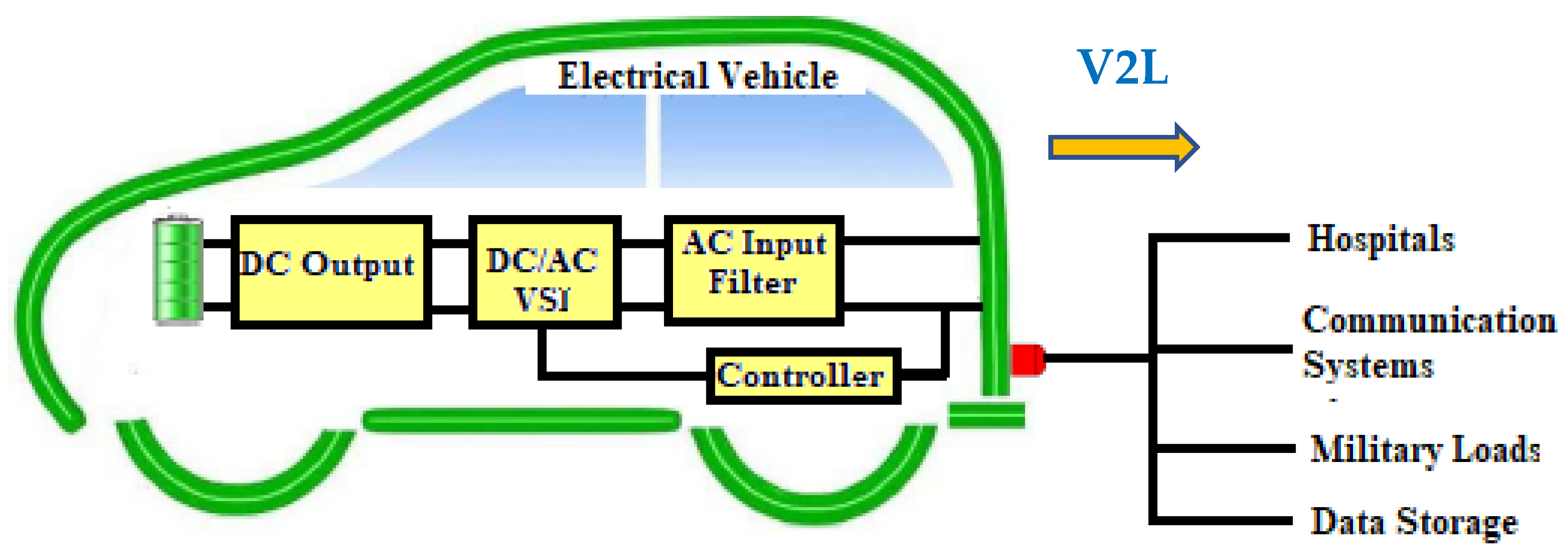
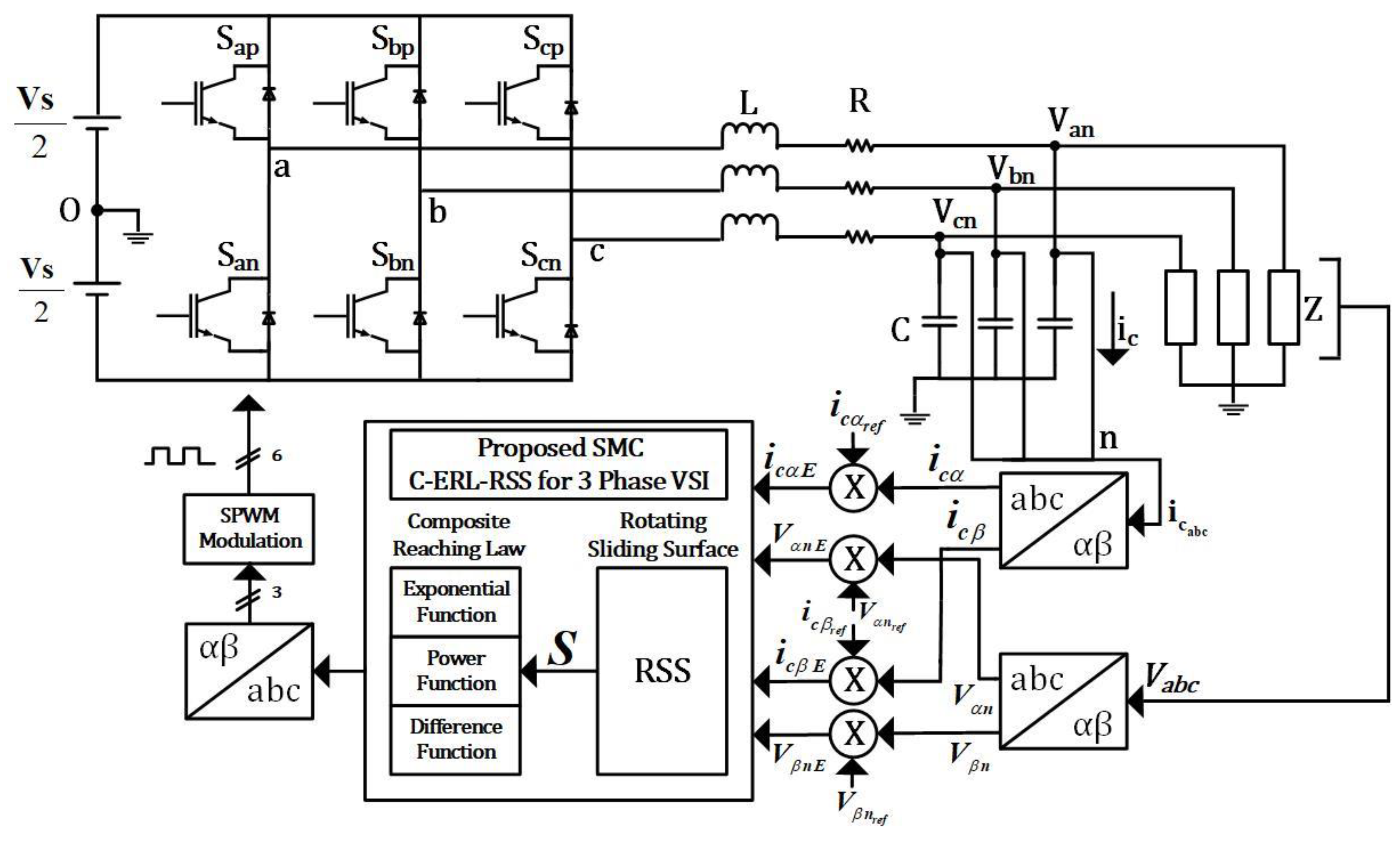
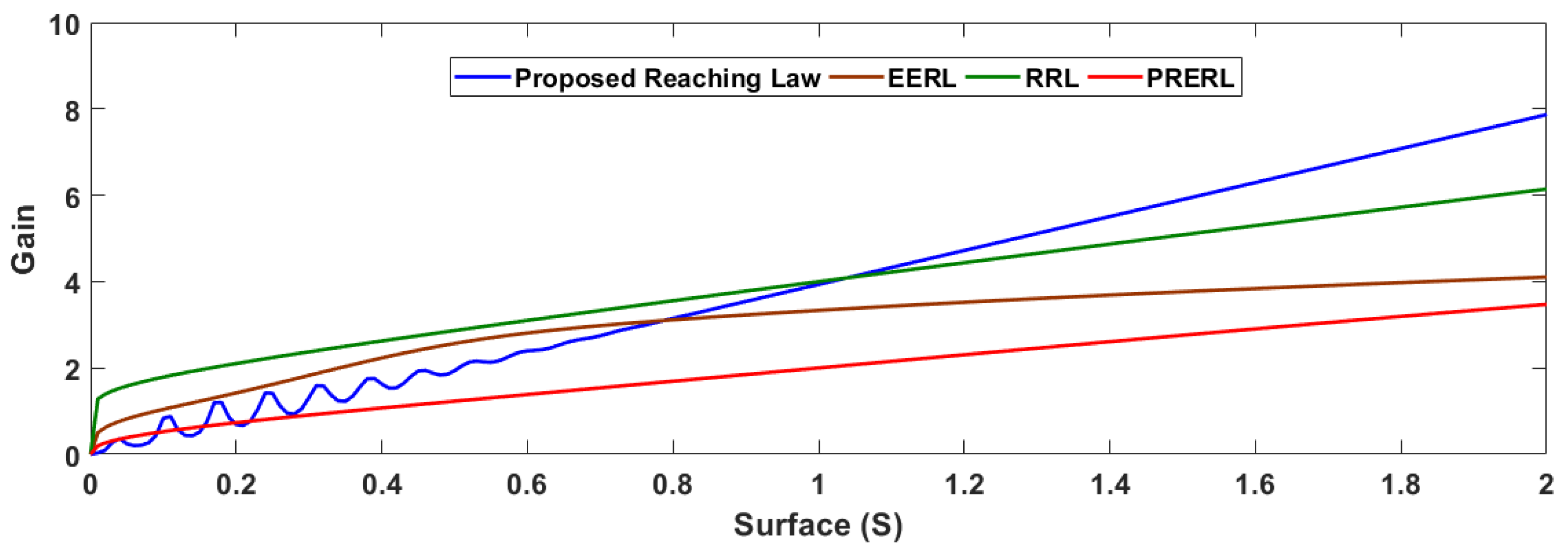
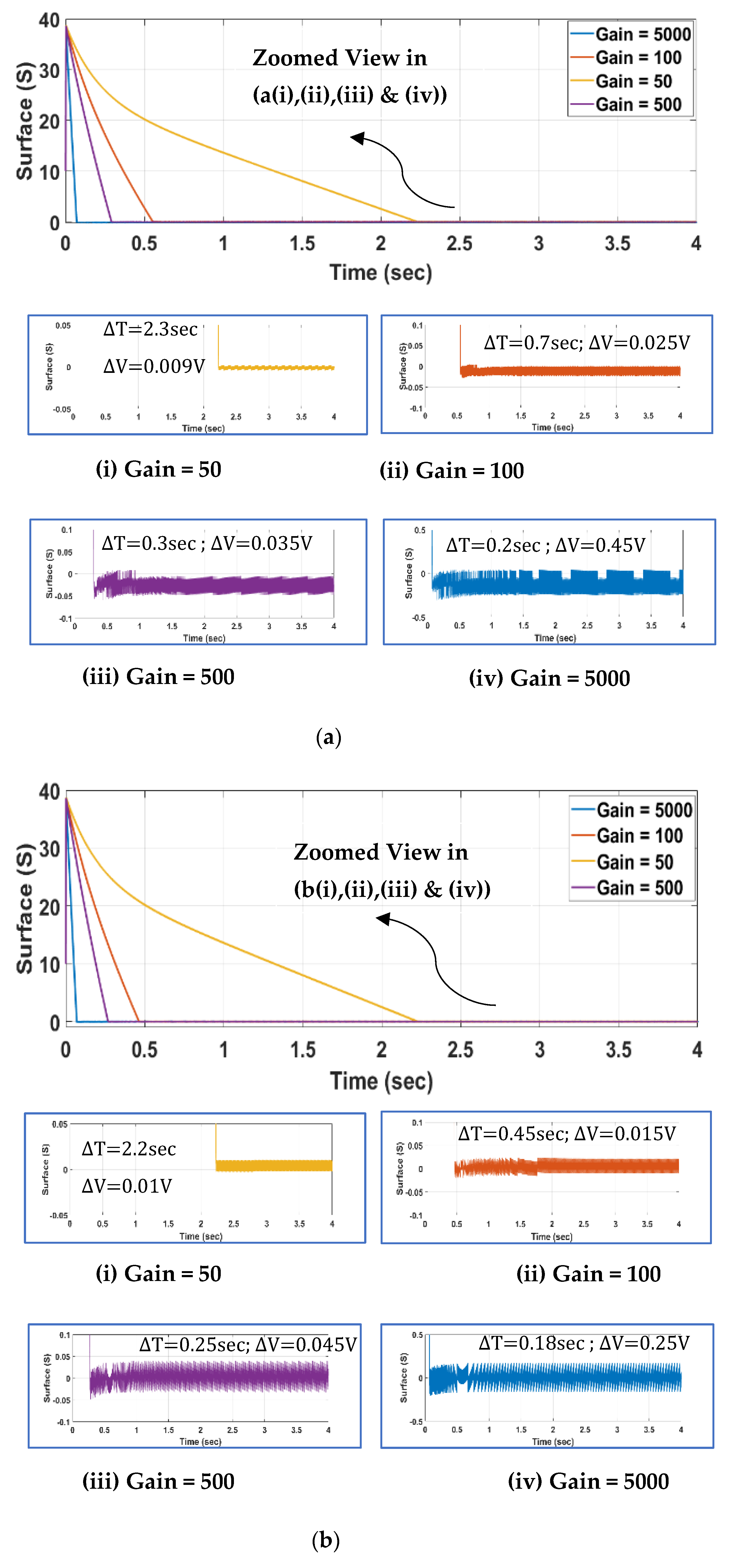

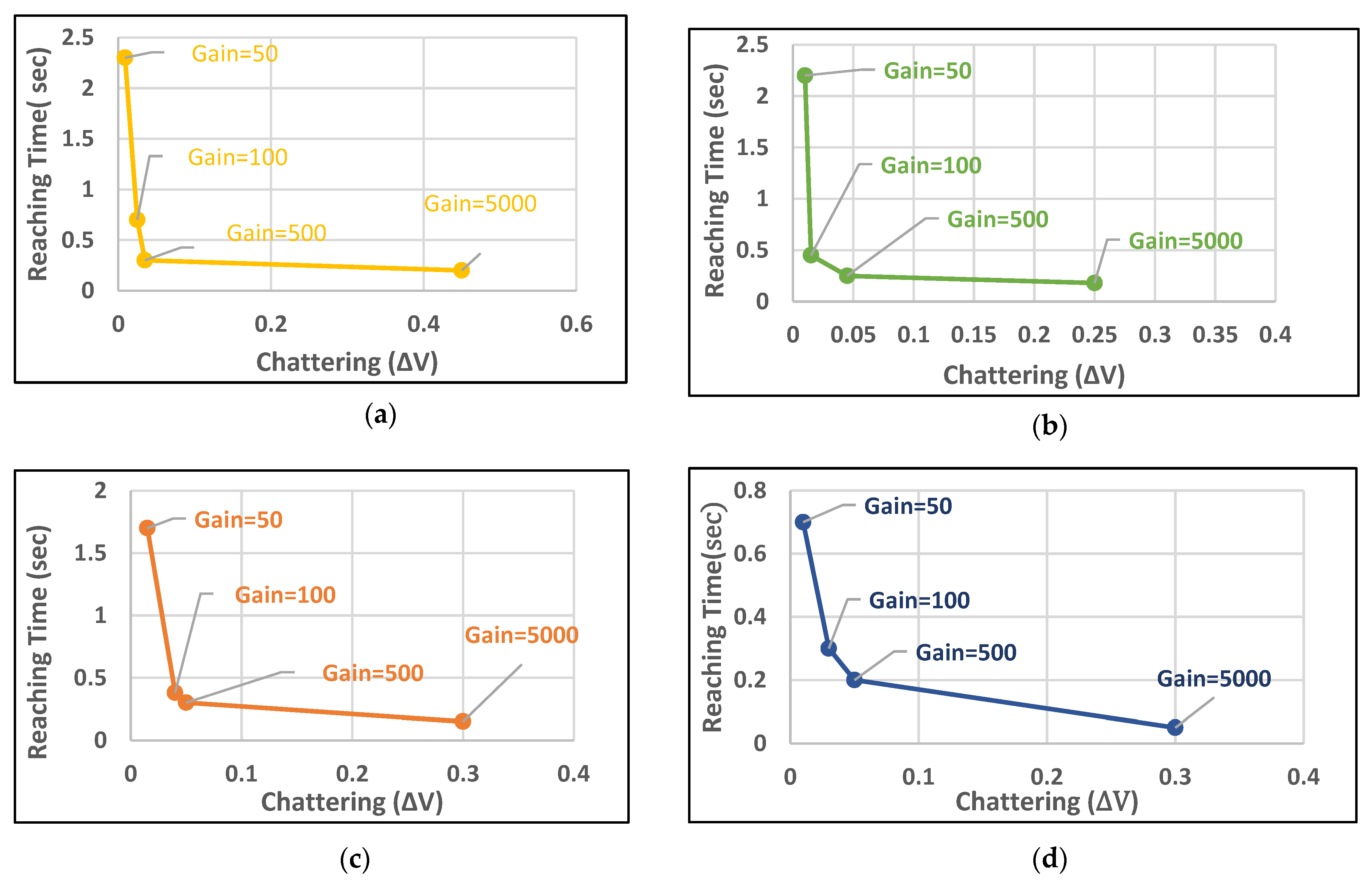
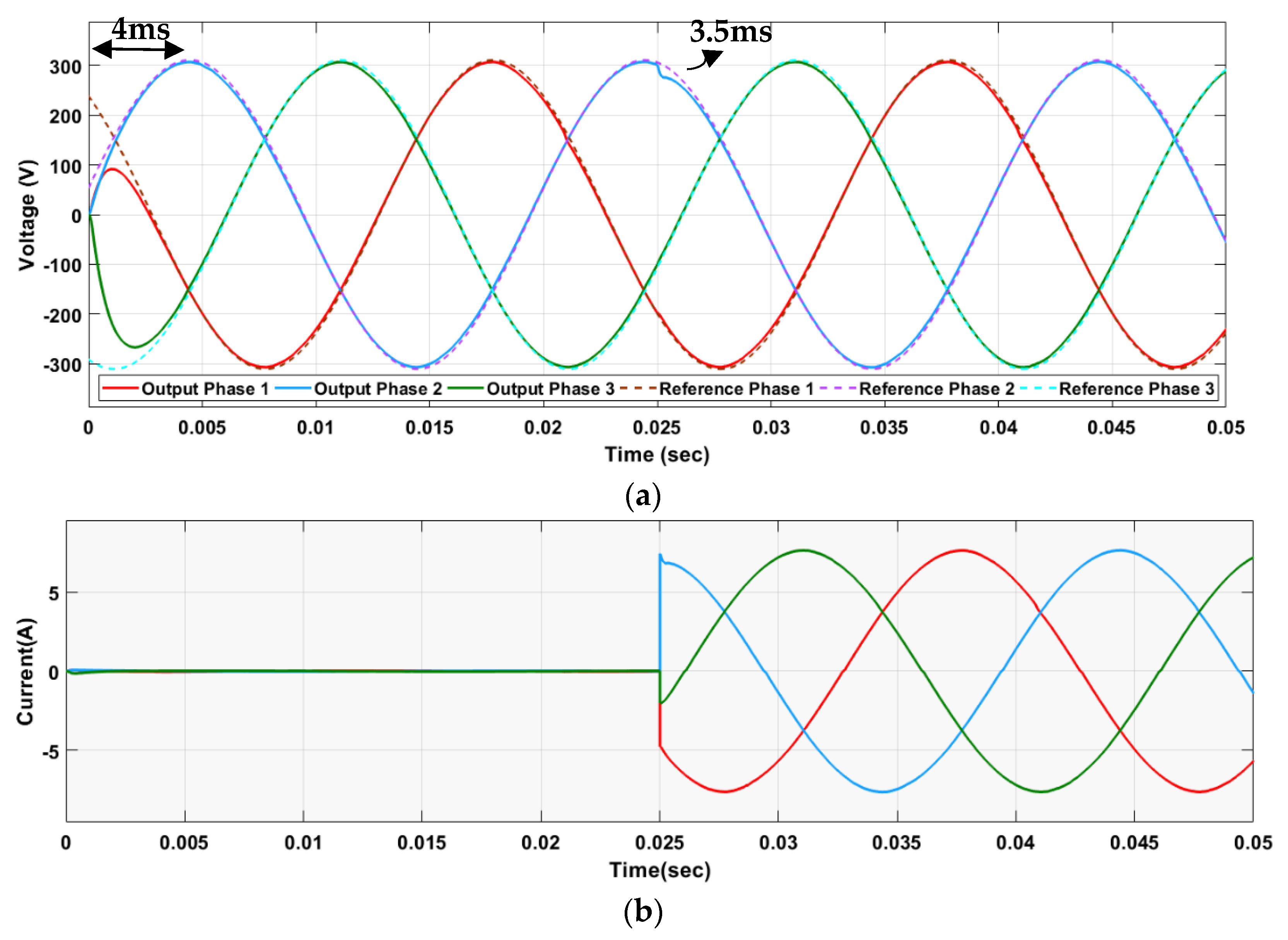
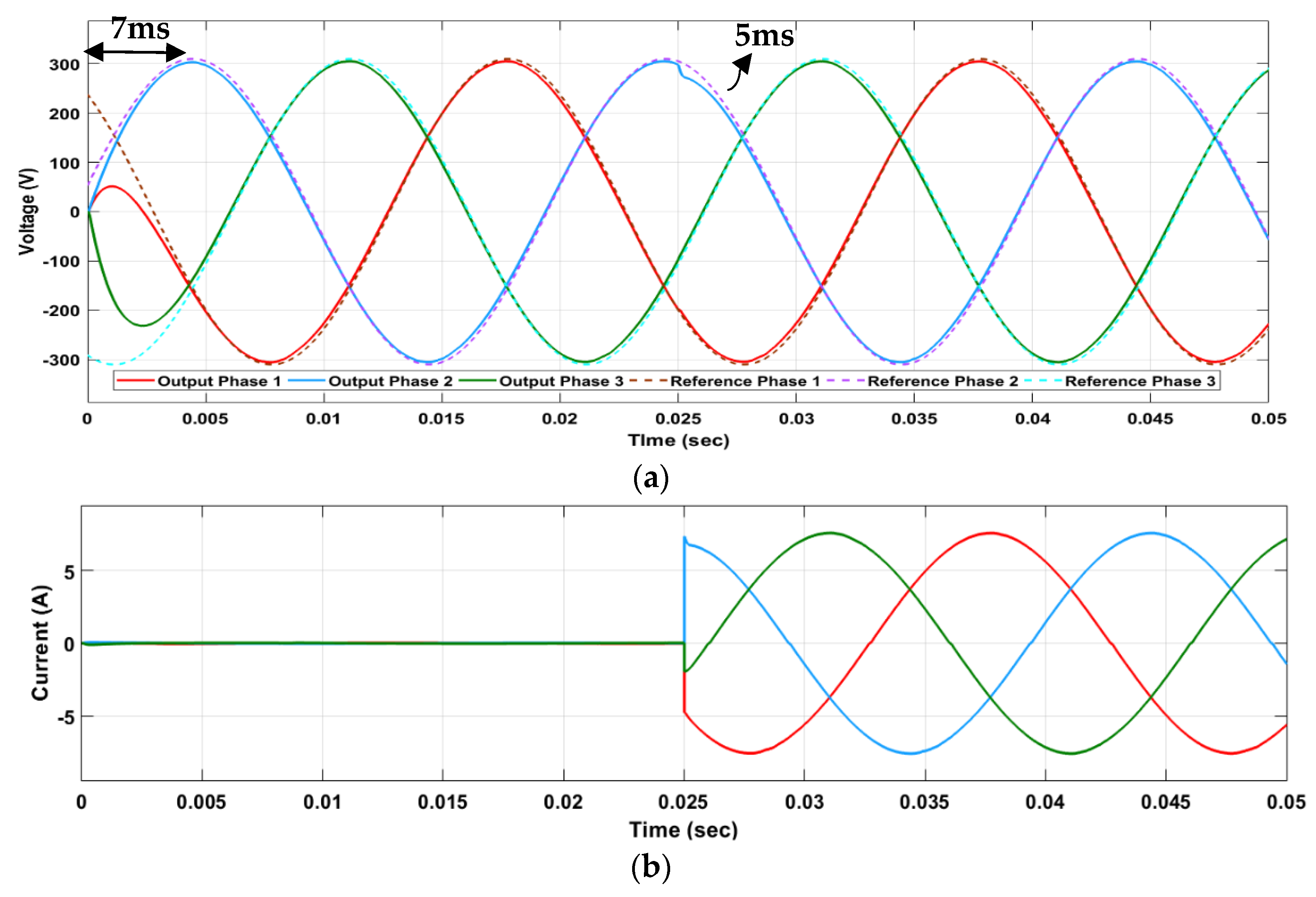
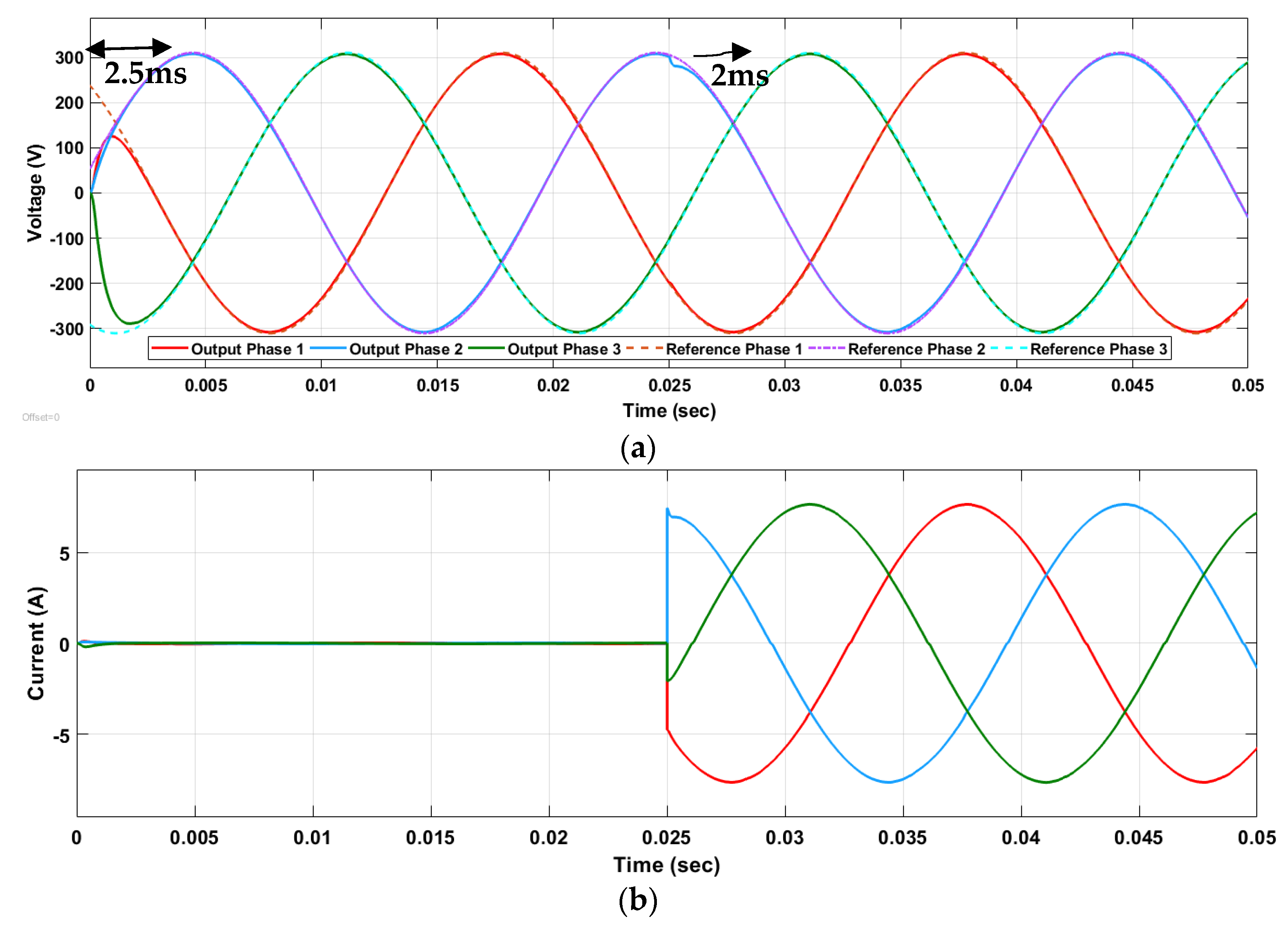
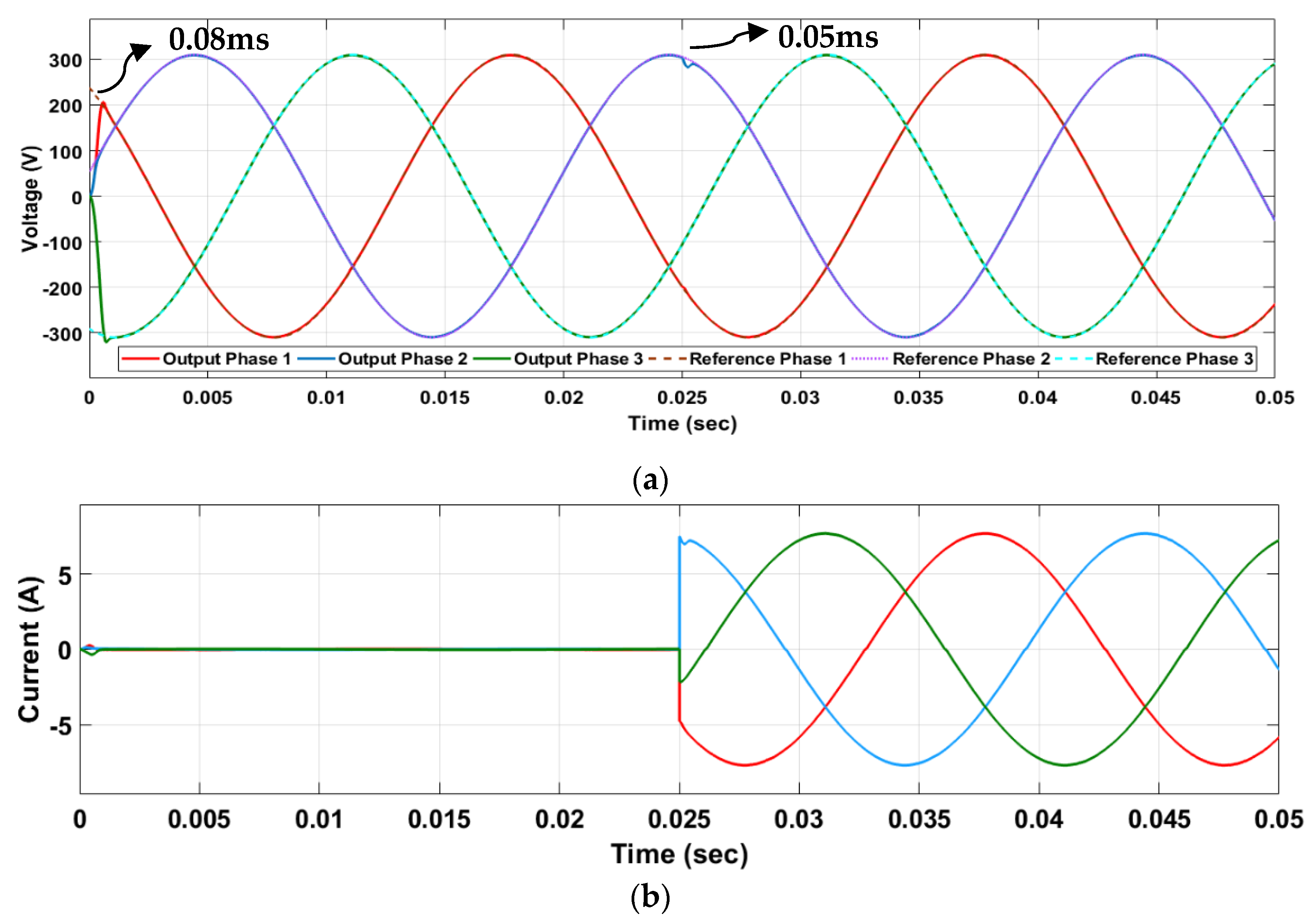
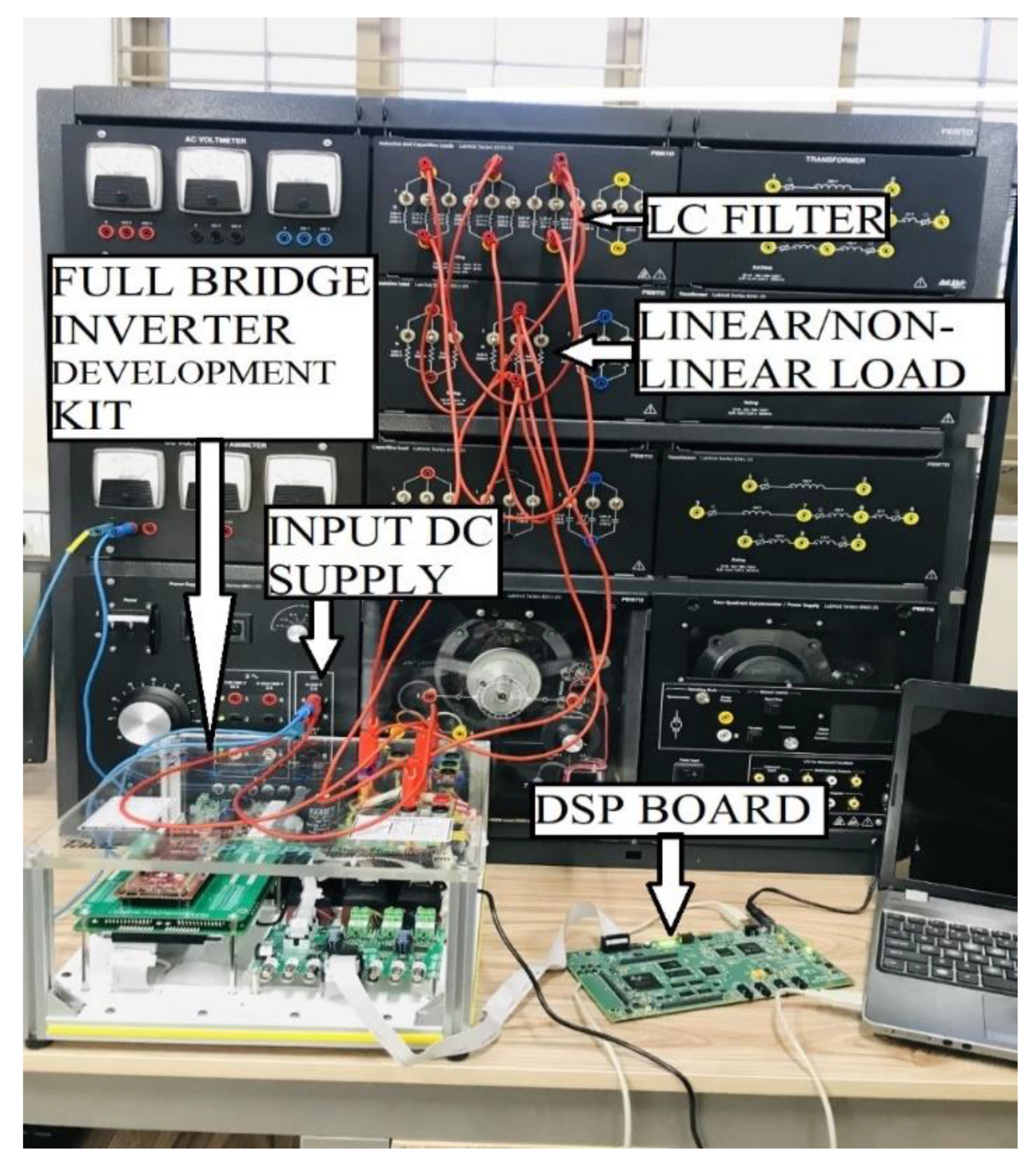

| Reaching Law | Parametric Values | |
|---|---|---|
| EERL [24] | ||
| RRL [29] | ||
| PRERL [27] | ||
| Proposed C-ERL-RSS | [24] |
| Reaching Law | Reaching Time | Chattering |
|---|---|---|
| EERL [24] | High | Moderate |
| RRL [29] | Moderate | High |
| PRERL [27] | High | Low |
| Proposed C-ERL-RSS | Low | Low |
| Circuit Parameters | Value |
|---|---|
| Input DC Voltage from Battery, | 500 V |
| Reference Voltage, | 220 V |
| Filter Inductor, | |
| Filter Capacitor, | |
| Scaling Gain, | |
| Scaling Gain, | |
| Non-Linear Rectifier Load (Z) | 1 KW |
| Switching Frequency, [14] | 9 kHz |
| Fundamental Frequency | 50 Hz |
| Controller | SMC [36] | DSMC [37] | TSMC [38] | PRERL [27] Compared in This Paper | RRL [29] Compared in This Paper | EERL [24] Compared in This Paper | Proposed C-ERL-RSS |
|---|---|---|---|---|---|---|---|
| Input—(V) | 360 | 250 | 250 | 500 | 500 | 500 | 500 |
| Reference— (V) | 220 | 110 | 110 | 220 | 220 | 220 | 220 |
| Output— (V) | - | - | - | 218 | 217 | 218.4 | 219.63 |
| 15 | 10 | 20 | 09 | 09 | 09 | 09 | |
| %THD | 1.7% | 1.6% | 5.1% | 2.3% | 3.2% | 1.8% | 1.1% |
| %Voltage Regulation | - | - | - | 99.09% | 98.63% | 99.27% | 99.83% |
| Robustness | - | - | - | Good | Good | Better | Best |
| Tracking Time (ms) | - | - | - | 4 | 7 | 2.5 | 0.08 |
| Transient Time (ms) | 0.5 | 2 | 2 | 3.5 | 5 | 2 | 0.05 |
Disclaimer/Publisher’s Note: The statements, opinions and data contained in all publications are solely those of the individual author(s) and contributor(s) and not of MDPI and/or the editor(s). MDPI and/or the editor(s) disclaim responsibility for any injury to people or property resulting from any ideas, methods, instructions or products referred to in the content. |
© 2022 by the authors. Licensee MDPI, Basel, Switzerland. This article is an open access article distributed under the terms and conditions of the Creative Commons Attribution (CC BY) license (https://creativecommons.org/licenses/by/4.0/).
Share and Cite
Haroon, F.; Aamir, M.; Waqar, A.; Mian Qaisar, S.; Ali, S.U.; Almaktoom, A.T. A Composite Exponential Reaching Law Based SMC with Rotating Sliding Surface Selection Mechanism for Two Level Three Phase VSI in Vehicle to Load Applications. Energies 2023, 16, 346. https://doi.org/10.3390/en16010346
Haroon F, Aamir M, Waqar A, Mian Qaisar S, Ali SU, Almaktoom AT. A Composite Exponential Reaching Law Based SMC with Rotating Sliding Surface Selection Mechanism for Two Level Three Phase VSI in Vehicle to Load Applications. Energies. 2023; 16(1):346. https://doi.org/10.3390/en16010346
Chicago/Turabian StyleHaroon, Faheem, Muhammad Aamir, Asad Waqar, Saeed Mian Qaisar, Syed Umaid Ali, and Abdulaziz Turki Almaktoom. 2023. "A Composite Exponential Reaching Law Based SMC with Rotating Sliding Surface Selection Mechanism for Two Level Three Phase VSI in Vehicle to Load Applications" Energies 16, no. 1: 346. https://doi.org/10.3390/en16010346
APA StyleHaroon, F., Aamir, M., Waqar, A., Mian Qaisar, S., Ali, S. U., & Almaktoom, A. T. (2023). A Composite Exponential Reaching Law Based SMC with Rotating Sliding Surface Selection Mechanism for Two Level Three Phase VSI in Vehicle to Load Applications. Energies, 16(1), 346. https://doi.org/10.3390/en16010346







